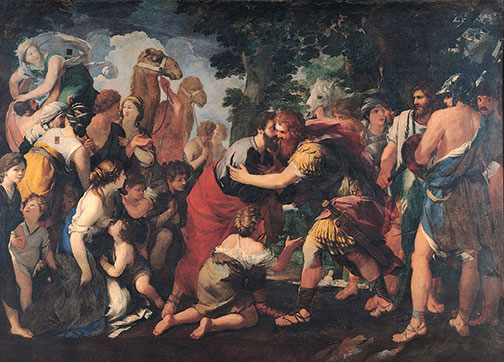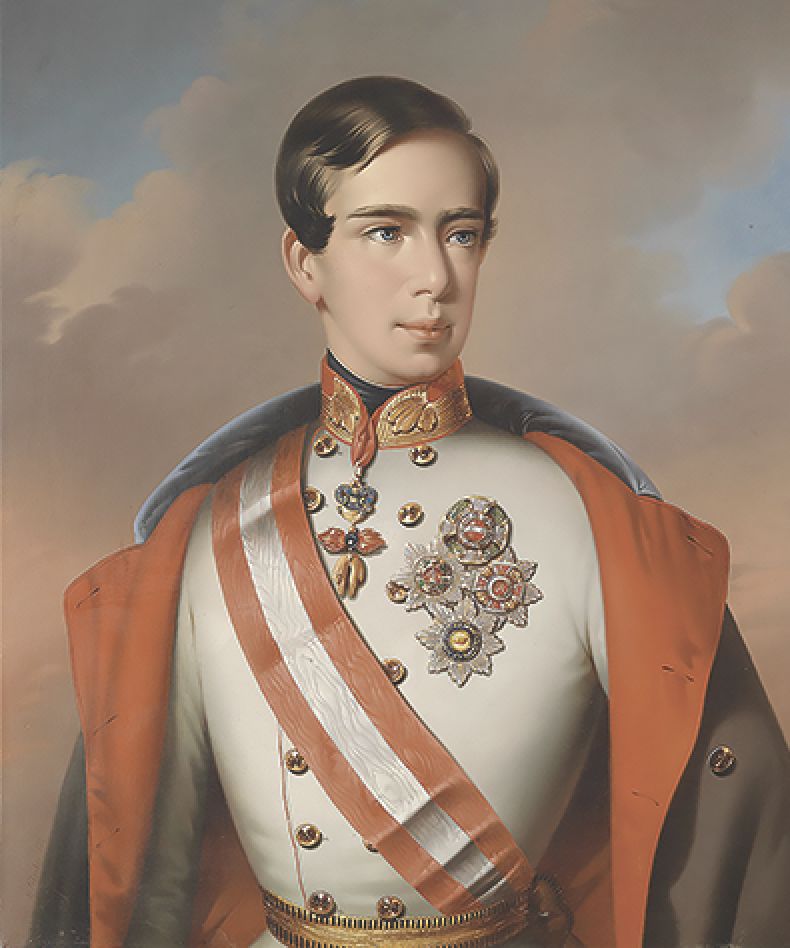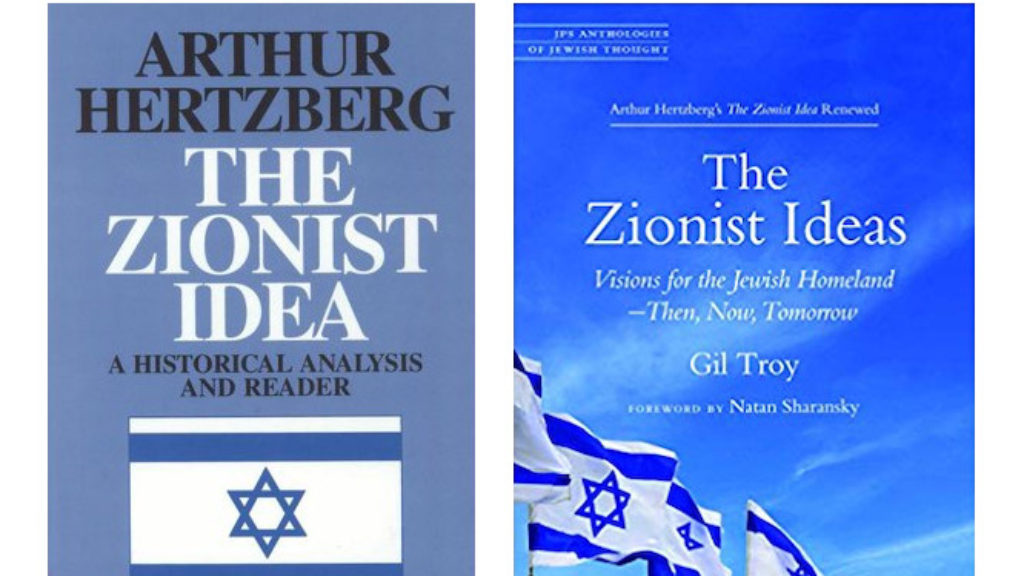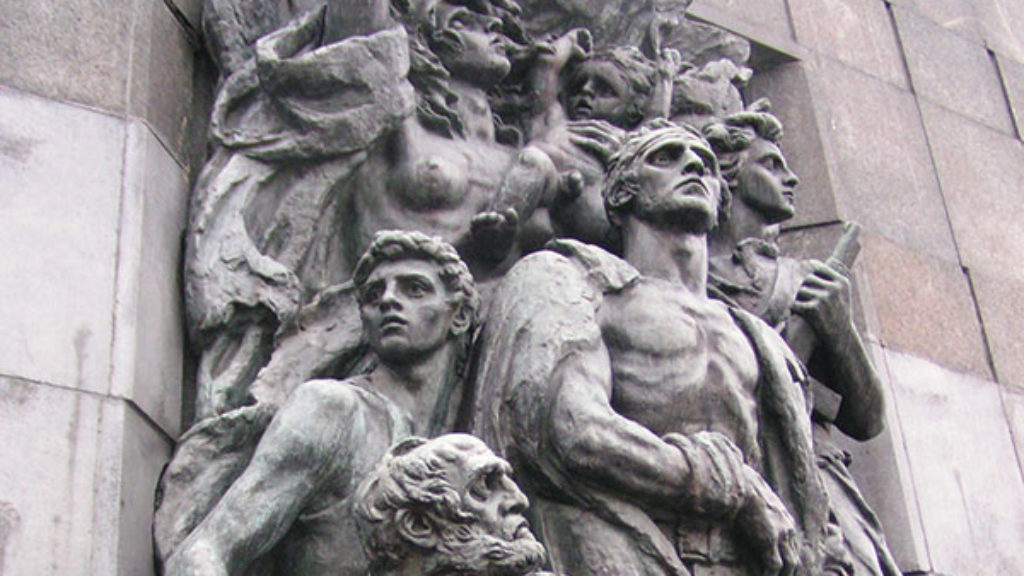“Jacob Gazed into the Distant Future”
Most Jews today know Jacob and Esau as the twin sons of our ancestors Isaac and Rebecca, embroiled long ago in a nasty family drama that peaked in the gentle Jacob’s somehow acceptable theft of his rough-hewn, hairy-handed brother’s birthright, and culminated in the two brothers’ awkward reconciliation on the far side of the Jabbok River. They know, too, that Jacob went on to become Israel, the eponymous forefather of God’s chosen people, and, if they were paying attention in Hebrew school or Intro to Bible, that Esau became the ancestor of Israel’s cruel neighbor, Edom. Most people don’t know, however, that the rivalry between the two brothers persisted in the conflict between—initially—the real Israel and the real Edom, and—subsequently, and more importantly—between the real Israel and the supposed heirs of Edom: Rome and Christianity. In Jacob & Esau: Jewish European History Between Nation and Empire, Malachi Haim Hacohen provides a dense but lucid account of how the history of this typology of sibling rivalry unfolded, first in the later books of the Bible and then, following the invention of a linkage between Edom and the Roman Empire, in rabbinic literature, and, finally, in later Jewish and Christian writings, down to modern times. But Hacohen’s book is not just the history of a literary trope; he also wants to “tell a European story that highlights traditional Jews,” who understood the events of their own times in terms of it, and to do so in a way that will be of use to present-day and future Jews.

Hacohen situates this story, rather unusually, in “Jewish European history.” If he doesn’t call it European Jewish history, like just about everyone else, it’s not because he wants to decenter anyone’s Jewishness. What he wishes to stress is that the Jews’ experience in Europe should be understood as that of very longtime and central participants in the formation of the continent’s culture. Telling this story is, in Hacohen’s eyes, an urgent task. He believes that the lessons that emerge from both the premodern traditions concerning Jacob and Esau and his version of Jewish European history can benefit the Jews of the whole world, who face a future that will be very different from the present.
“How could Edom become Rome, Esau’s hands become Caesar’s?” Hacohen writes, riffing on Genesis 27:22 (“yet the hands are the hands of Esau”), while asking a standing historiographical question. It was not, of course, through any kind of genealogical research but the result of historical experience. But which experience? Was it defeat at the hands of the Romans in the 1st century that inspired the rabbis to graft their new enemy onto their old one, or did they do so only much later, after Rome had fallen victim to an originally Jewish heresy that laid claim to Jacob’s heritage? Hacohen answers this question decisively. Parting company with many scholars of antiquity, most famously Jacob Neusner, he argues that “the Roman Empire and not Christianity was crucial to rabbinic Edom” and goes on to argue that
the late antique Christian–Jewish dialogue may have been more limited than some imagine; and that European Christendom’s formation in confrontation with Islam first fixed the Jewish gaze on the Roman Empire’s religious character and triggered the Christianization of Edom and Esau.
It was the Crusades, however, that “completed Edom’s Christianization” and “shifted the major target of Jewish hatred from empire to church” without altogether dissociating the Holy Roman Empire from Edom. The “Roman Church, leading Crusades across the Mediterranean against the Muslims and in Europe against heretics, and overseeing the Inquisition, was the one to look truly imperial—Europe’s leader and the Jews’ mortal enemy.” The church, Hacohen writes, “overshadowed the empire.”
Whether it was focused on the empire or the church, and whether it was deployed by rabbis, poets, or mystics, the Jewish typology remained basically the same, depicting an ongoing struggle between “Jacob-Israel, praying to God and fulfilling the commandments,” and a “violent rebellious Esau, the representative of cosmic evil.” Born of defeat, these images discouraged political activism. “Jacob & Esau testifies,” Hacohen tells us, “to the potency of memories of destruction and exile, to perpetual Jewish yearning for redemption and vengeance, and, above all, to a life of eternal waiting.” To illustrate the paramount importance of boundless patience, Hacohen adduces the 6th-century liturgical poet Yanai, who ignored “Jacob and Esau’s reconciliation, and mildly [rebuked] Jacob for prostrating himself before Esau, “pleading” for redemption and revenge.” And he also tells us how the Zohar recounts that
When Jacob and Esau met, Esau offered Jacob to “let us share together this world,” but Jacob declined: “You have first your dominion of this world, and [I shall] reserve myself for the world to come and for the latter days” (171a)… “Jacob gazed into the distant future . . . when his descendants should need the blessings in the struggle against the nations of the world . . .
and therefore deferred the[ir] fulfillment” (145a, 172a).
Usurping on behalf of their own people the role of “the true Israel,” some of the church fathers were inspired, naturally enough, to turn the typological table and brand the Jews as the descendants of Esau. But this was a relatively marginal phenomenon until deep into the Middle Ages, when “the first full-blown Christian typology of Jewish Edom” emerged from the pen of a convert from Judaism, Archbishop Paul of Burgos. By the early modern period, at least among some Protestant theologians and painters, Jacob and Esau came to symbolize not Christian and Jew but Catholic and Protestant, and the emphasis fell not on their rivalry but on their final reconciliation.
Reflecting the development of a new modus vivendi between Christians and Jews, the old myth of eternal enmity between estranged brothers tended to disappear from early modern Jewish texts, from the early 17th-century Yiddish “women’s Bible,” Tsene-Urena, to Moses Mendelssohn’s Biur. Later, in 19th-century Central Europe, the typology was “revitalized, repressed, transformed, rechanneled, and deflected, all in an effort to make it possible for Jacob to become a modern European Jew.” For early Reform preachers, for instance, “Esau remained a negative type, but he came to embody Jewish apostasy and pagan hedonism, rather than Christian malevolence.” Samson Raphael Hirsch, one of the founders of modern Orthodoxy, “presented Jewish emancipation as fulfilling Jacob & Esau’s reconciliation.” But the antagonistic Esau didn’t altogether vanish, even from Reform discourse:
At the height of the emancipation struggle in Austria in December 1862, none other than German integration’s chief Jewish exponent, Viennese Rabbi Adolf Jellinek (1821–1893), burst out during an anxious sermon against emancipation’s opponents: “Deliver me, I pray Thee, from the hand of my brother, from the hand of Esau; for I fear him, lest he come and smite me, the mother with the children” (Genesis 32:11).
As Hacohen chillingly reminds us: “Little did he know!”
One of the central idiosyncrasies of this big ambitious book is that Hacohen combines his survey of the history of the “Jacob & Esau” typology with an even lengthier study of the predicament of the Jews in modern Europe that has little to do with it, though it does focus very heavily on the ostensible heirs to one of Esau’s incarnations, the Holy Roman Empire and its Austro-Hungarian successor. He devotes a considerable amount of attention to Jews living elsewherein the German cultural sphere, too, but scarcely mentions the Jews of Great Britain, France, or Italy, and he gives scant attention even to the Jews of Russia, who constituted for so long the majority of the Jews on the continent. This is because Hacohen isn’t really telling the story of modern European Jewry, he’s making an argument about it, and the Austro-Hungarian Empire, or at least the possibilities it seemed to hold out, is central to that argument. “[T]his book,” he writes, following in the footsteps of the great historians Salo Baron and Simon Dubnow, “highlights the protections and opportunities extended to Jews in pluralist imperial orders, especially in Austria-Hungary, as an alternative to national integration.”
If the modern Jews’ choice has been between nation and empire, as his book’s subtitle has it, Hacohen is decidedly against the former. He forcefully echoes Simon Dubnow’s famous criticism of the European nation-states for demanding that the Jews repudiate their distinctive national identities and merge with the general population. Like Dubnow, he singles out Count Stanislas de Clermont-Tonnerre, who in 1789, in the French National Assembly, promised everything to the Jews as individuals but denied them anything as a nation.
In Germany, when the Jews were “faced with the demand that they cease being a community,” they responded by formulating “pluralist visions of a multiethnic Germany, a nation-state united by a humanist political culture.” Unfortunately, “these visions, much admired today, had no traction among non-Jews. Nationalism liberated the Jews; the threat of banishment, should they fail to become part of the nation, always hung in the balance.” In the end, of course, racialized German nationalism denied the possibility of the integration of the Jews on any terms and led to their expulsion and much, much worse.
German racism became entrenched in the Austro-Hungarian Empire, too, but its non-German majority and highly diverse population left far greater scope for pluralist visions. By the beginning of the 20th century, even as many Austrian Jews continued to hope for complete integration among the empire’s Germans, others came to conceive of the Jews as a separate nationality that ought to enjoy autonomy within the imperial framework:
By offering the Jews the prospect of national autonomy, late imperial Austria extinguished the ghosts of Edom, lying dormant at its own foundation. Ancient Rome had put an end to Jewish autonomy and devastated the Jewish homeland; the monarchy, which traditional Jews saw as Rome’s successor, had been recreating a homeland for them.
But this moment was fleeting. “The monarchy’s disintegration in the aftermath of World War I dealt a debilitating blow to Jewish hopes for national autonomy.” The postwar Austrian republic that took part of its place was unable to “accommodate ethnic, cultural, and political diversity. Jews and other Austrians tell the European story of the nationalizing state’s failure.” The lesson to be learned from these developments is central to Hacohen’s entire narrative:
Since the nation-state emancipated the Jews, critics and admirers alike have regarded them as modernizers of European life. Austrian history suggests the opposite. The Jews flourished under the late empire; the nationalizing state, the heart of modernity, was their death writ.
For the Jews, the empire was gone but not forgotten. As Hacohen demonstrates, nostalgia for it was widespread among the Jewish intelligentsia in the decades after its demise and found expression not just in the works of authors such as Joseph Roth, Franz Werfel, and Stefan Zweig. An idealized picture of life under Emperor Franz Joseph maintained a continuous presence in Hebrew literature from “Rabi Binyamin to Shmuel Yosef Agnon to Haim Be’er . . . well into the State of Israel.”
Hacohen himself isn’t nostalgic for empire, exactly, but he does think that there are lessons from the historical experience that are worth remembering, especially for Jews. After World War II, he writes,
empire quickly became a pejorative term, associated with humanity’s darkest chapters. The idea that empire could be the historical norm and have something to recommend itself remained a taboo until the twenty-first century. The imperial world of Jews and other Austrians survived only in the literary imagination. This book has set out to reclaim it.
Nation-states still dominate our horizon, but they are, Hacohen writes, increasingly challenged by “novel forms of globalization and regional collaboration,” and “lessons derived from the imperial legacy” may help Jews to address their problems. Hacohen believes that it is very important to show how some of these lessons have been absorbed and applied in Austria. But he folds his account of developments there within a narrative of changes that took place throughout Europe, beginning in 1968, a tumultuous year that “was at once symbol and stimulant of internationalization.” In the ensuing years,
[t]he easing of the nation-state’s political and cultural boundaries, and the growing acceptance of a measure of ethnic and cultural diversity accompanying Europeanization, attenuated, though by no means resolved, the problem of Jewish difference. Crucial above all was the growing European confrontation with the Holocaust and the definition of a new Europe, in the 1990s, against the Holocaust experience. Even today, when xenophobic nationalism has returned, vivid memory of the European past, and the determination not to repeat it, still offers Jews a measure of protection from the hostility directed toward Muslim and Roma communities. The Jews have become European.
Hacohen does not substantiate these broad generalizations with an assessment of the state of affairs in all of the European countries that still have sizeable Jewish communities, and I am not at all sure that he could. Instead, he highlights the emergence in post–World War II Austria of a new generation of Jewish intellectuals who have “shaped new German-Jewish and European cultures.” And even about them he does not tell us very much.
Why did Malachi Hacohen compose this unusual book? On the next-to-last page of the epilogue, he writes:
Let it be remembered that there was a moment in history when a postorthodox Jew could imagine European culture accepting traditional Jews, and, indeed, recognizing them as an important marker of its history and culture.
That Hacohenis a postorthodox Jew is something previously disclosed only in his acknowledgments and introduction, and even there the reader is left wondering exactly what he means. “Postorthodox Jews, like this author,” he writes in one of his first footnotes, “are traditional Jews conscious of their tradition’s historicity,” but since, in Hacohen’s rather idiosyncratic terminology, “traditional Judaism” means rabbinic Judaism so broadly conceived as to include the Reform movement, this doesn’t help much. Setting this question aside, whose memory does he wish to assist in this passionate invocation? Not Jewish Europeans, for he seems quite doubtful about their prospects, after “recent waves of populist nationalism” have thrown “the postwar order, the EU, and the transatlantic world into a crisis.” This turn of events has led him to fear that “the anomaly of the postwar moment in Jewish European history may be approaching its end more quickly than I anticipated.” “World Jewry’s future,” he recognizes, “is not in Europe.”
He doesn’t think it’s in the State of Israel either. Hacohen is, for one thing, “pained and ashamed . . . by the injustice that Jewish power has inflicted on the Palestinians, and its gross insensitivity to the humanity of others.” He is even more disturbed by the way in which “the inexorable logic of religious ethno-nationalism” has led some prominent religious intellectuals in Israel to exalt Esau as an honorable warrior and to incorporate him into their national ideal. For such people, he laments, “Jacob has turned into Esau.”
In his first chapter, he refers to the state provocatively, but in passing, along with ancient Judah and the Hasmonean Kingdom, “as short episodes of Jewish sovereignty . . . contingent on Near Eastern imperial lulls: the short-term absence of a hegemonic regional empire.” Almost 600 pages later, he puts things much more clearly:
If history offers any instruction, it is that the ethno-national conflict in Israel-Palestine will run its course, and the second Hasmonean state will have reached its end in my own daughters’ lifetime. A catastrophic end is not impossible, but more likely it will be an implosion, the ethnically and religiously diverse population in the Land between the Mediterranean and the Jordan River claiming, albeit not necessarily receiving, their citizenship rights (or their equivalent). The Land’s historical diversity will reemerge with no empire yet in sight to impose order. The worst scenarios of ethnic massacres may be exaggerated, but Israeli–Palestinian relations give no grounds for hope of peaceful coexistence either, and one recalls that Jewish–Hellenic confrontation in Caesarea ignited the Jewish–Roman war that ended in Jerusalem’s destruction à¢ááúåú.
This dismal prospect does not entirely demoralize Hacohen. The Hebrew letters at the end of his sentence, as he does not explain, stand for these words: May it be rebuilt and reestablished quickly in our days, amen. More reassuringly, Hacohen then muses that in the aftermath of destruction “[m]any a Jacob will then again be crossing the Jordan River with their staffs, hoping to rebuild a community abroad and, yet again, return.”

Malachi Hacohen, an Israeli émigré who teaches at Duke University, apparently sees himself as just such a Jacob and also seems to regard his new book as, to some extent, a means of rebuilding a community in the diaspora—in preparation for some future return of the Jews to the Promised Land. In his epilogue, he looks back on his long, “loving postmodern exploration of premodern traditions” and proceeds to contemplate the way in which it might assist his teenage “daughters, Hadas and Lilach, and their (future) children,” who “will need to recover the experience of Jewish life in a state of expectation and relearn to wait”—like their ancestor Jacob.
What should they be waiting for? Maybe something that will never come. “Jacob & Esau testifies . . . above all,” Hacohen tells us, as I have already noted, “to a life of eternal waiting.” Perhaps for at least one postorthodox Jew, waiting—forever—is what it’s all really about.
On the other hand, there is Hacohen’s dark prognostication of an implosion in Israel that will be followed by a time when “no empire” is “yet in sight to impose order.” If and when such an empire does eventually loom into view, he may be thinking, the Jews who will still live in the Land of Israel, and others elsewhere who will care about them, might benefit greatly from all of Jacob & Esau’s lessons concerning the shortcomings of the nation-state and the virtues of empire, especially for the Jews.
Jacob & Esau is a sprawling, often scintillating book, a work of great range and depth. Hacohen’s analyses of the political outlooks of modern rabbis of very different stripes, ranging from Moses Sofer to Samson Raphael Hirsch to Adolf Jellinek, are innovative and eye-opening. His 10-page intellectual biography of the literary critic Erich Auerbach does a marvelous job of explaining that man’s complex and regrettable attitude toward his Jewish heritage.
Nonetheless, his book contains a disconcerting number of errors, small and large. I’ll mention only three, one ancient, one medieval, and one modern, each of which at least touches on a key theme of Jacob & Esau. Hacohen writes that the rabbis of the second century “shrank from declaring Bar-Kokhba a false messiah, but they would not recognize him as Messiah son of Joseph, presaging Messiah son of David and destined to fall in war.” To support this assertion, he refers us to scholar of midrash Joseph Heinemann’s classic Agadot ve-Toldotehen. On the very pages Hacohen cites, however, Heinemann actually argues that the rabbis probably developed the concept of a preliminary Messiah son of Joseph who dies in battle only after Bar Kokhba went down in defeat, in order to salvage the reputation of the slain but still-admired hero.
Moving to the Middle Ages, Hacohen writes that, “Even the vicious anti-Jewish polemics of Peter the Venerable (1092–1156) and Bernard of Clairvaux (1090–1153) did not seek to undermine the Jews as a protected minority.” Astonished to find Bernard described so harshly despite his strenuous efforts on behalf of the Jews during the Second Crusade, I checked Hacohen’s source, an article by Jeremy Cohen in the American Historical Review on the “study and evaluation of Judaism in European Christendom,” in which Cohen does not mention Bernard (though he has done so in several other publications, without ever describing him as a vicious anti-Jewish polemicist).
“Well into the 1780s,” Hacohen writes of the Jewish Enlightenment, “the Haskalah tweaked early modern parameters but could not imagine emancipation.” Moses Mendelssohn, the great standard-bearer of the Haskalah, he writes, could not “foresee Jewish citizenship in the nation-state, the quid pro quo of complete equality for complete integration.” But that is precisely what Mendelssohn bargained for in his Jerusalem, a book that unequivocally argued that every citizen in the state, regardless of religion, was entitled to full equal rights.
Of course, mistakes in a book of Jacob & Esau’s scope and ambition are inevitable. Still they ought to give the reader some pause, for the rhetoric of Hacohen’s book turns less on persuasive historical argument than an apparent sovereign command of more than 2,000 years of Jewish history and literature, which underwrites his vision of the whole. “Going beyond the polemics on Zionism,” Hacohen tells us, his book “makes it possible for pre-Holocaust and pre-Israel historiography, grounded in the longue durée, to speak to the Jewish future.” He writes, then, if not for the ages than for the next age, when the explosion or implosion that he quietly predicts in Israel will already have occurred, the dust will have settled, and the surviving Jews will be able to begin their work of reconstruction. No longer blinded by what he at one point calls “the miraculous Jewish State,” they “will need to fashion new paradigms to explain the Holocaust and the Jewish State’s place in Jewish history”—with Hacohen’s presumably posthumous assistance. If, God forbid, that day should ever come, and a new post-postorthodox Yavne is convened, I greatly doubt that Hacohen’s scholarly tome will be of much help to its sages.
Jacob & Esau is a brilliant, bewildering medley of myth, history, literary criticism, and prophecy. Readers should mine it (carefully) for what is valuable and disregard what Hacohen thinks about what lies ahead and how we ought to deal with it.
Suggested Reading

Zionisms Abound
Gil Troy and Allan Arkush on Troy’s new book, The Zionist Ideas.

Du Bois, the Warsaw Ghetto, and a Priestly Blessing
When the editors at Jewish Life asked the venerable civil rights leader W. E. B. Du Bois to speak about the Warsaw Ghetto uprising, they had no idea that it would lead to a priestly blessing.

Jokes and Justice
We were sitting in our apartment one evening when a Spanish philosopher dropped in ...
The Genius of Bernard-Henri Lévy
Bernard-Henri Lévy's amour propre, while immense, does not quite extend to regarding his life as exemplary in its Jewishness, nor to tying all of his political actions to Judaism.
Comments
You must log in to comment Log In